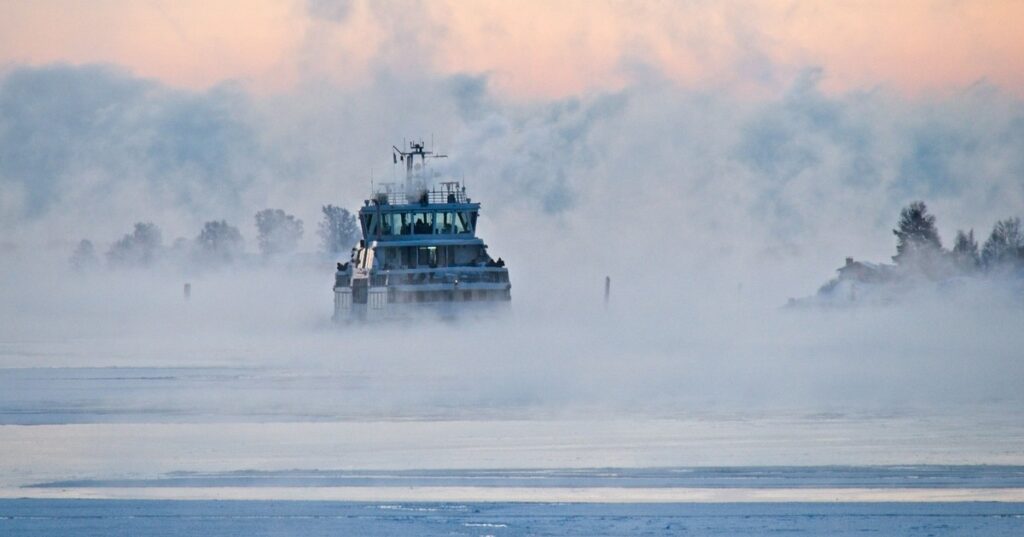Sea smoke is an eye-catching nautical phenomenon. In a nutshell, it’s a thick layer of fog that sometimes appears on the surface of oceans, lakes and rivers — especially in colder climates. It goes by many names around the world, including steam fog, white frost and black frost.
Whatever someone call it, sea smoke is a dangerous obstacle for maritime workers and travelers. It’s also a telltale sign the oceans are becoming increasingly polluted in the air and underwater. Take a look at the science behind sea smoke, explore its harmful effects and discuss some eco-friendly initiatives that can reduce the presence of sea smoke.

What Is Sea Smoke?
Sea smoke’s name can be deceiving because it isn’t smoke at all — it’s water vapor. It often looks exactly like the regular fog one might see early in the morning on a cold day. Fog develops the same way on land and sea — when cold air mixes with warm air along the ground or the ocean’s surface, causing moisture to evaporate and raising humidity levels.
Once the humidity reaches a certain point, the air can no longer contain the evaporated moisture in its gaseous form. As a result, the water is forced to condense into fog. Since marine climates are already humid, sea smoke is a common occurrence. It also tends to happen at night and just before sunrise because of the colder temperatures.
Sea smoke has earned nicknames like “steam fog” because it can linger longer than regular fog, especially if there is no wind. The ocean provides an ideal environment for fog to thicken and develop a wispy steam-like texture. It might look visually appealing on the calm ocean surface, but it poses some major problems for seafarers.
Reduces Visibility
The most immediate problem sea smoke creates is a reduction in visibility. When you’re out at sea, conditions are already poor enough in the middle of the night, but sea smoke makes the surrounding waters practically invisible. Ships caught in the dense fog risk going off course, hitting debris in the water or colliding with another vessel.
Traveling through sea smoke also forces the ship navigators to react quicker to any obstacles in the water and reduce speed in order to maintain a safe speed. Ships going through sea smoke might have to perform tight and dangerous maneuvers to avoid an accident.
Creates Water Hazards
Sea smoke can be considered a water hazard, but it also creates other risks. If temperatures are cold enough, the fog will freeze onto the hulls of ships and any debris floating in the water. As a result, large chunks of ice can form and create more obstacles for the vessel to account for.
The best way to address this issue is to keep the boat fenders clean and make sure no ice chunks develop on them. The fenders can protect the rest of the ship from ice chunks floating in the water — as long as they don’t reach glacier size, which is rare.
Leads to Unsafe Ship Conditions
Sea smoke also leads to unsafe conditions on the ship. It keeps the air frigid and uncomfortable, sometimes causing temperatures to plummet into the negatives. Freezing temperatures can cause the ship’s outer deck to develop its own thin layer of ice, creating many opportunities for slips, falls and injuries.
More ships are transitioning to rubber flooring because of its non-slip properties and resistance to extreme maritime weather conditions. Rubber flooring has many installation options, so it has become a mainstay on commercial vessels of all shapes and sizes.
Another risk is that a thin layer of ice can increase the weight of the ship, reduce the metacenter, and therefore the stability of the ship.
Indirectly Contributes to Air Pollution
Sea smoke should not be confused with haze, a visually similar phenomenon that occurs in cities from environmentally-damaging airborne particles. While haze is a form of pollution, sea smoke is just harmless water vapor. However, it still indirectly contributes to air pollution.
Reducing visibility might cause delays in shipping routes and make large vessels burn more fuel, leading to more CO2 emissions. In a similar way, forcing the ships to change directions frequently burns more power and causes more air pollution.
How Maritime Travel Worsens the Sea Smoke Problem
Over the years, constant maritime travel for commercial or recreational purposes has changed the ocean’s climate. Ocean-going ships make up 3% of global carbon emissions yearly. That number might seem small compared to other industries, but not when you consider 90% of energy trapped by greenhouse gasses ends up in the oceans.
The introduction of greenhouse gasses to any environment leads to higher temperatures. The endless traffic of ships has contributed to a significant increase in ocean heat content in the last few decades. Temperature fluctuations are now more extreme — especially during the winter months — creating an ideal environment for developing sea smoke.
It’s important to acknowledge pollutants released from ports worldwide also cause global warming and a higher prevalence of sea smoke. The most dangerous pollutants include high amounts of particulate matter, nitrogen oxides, sulfur oxides, and carbon monoxide.
All types of activity related to the shipping industry have made the sea smoke problem worse. Vessels can damage ocean air and water quality most, but the heavy equipment and vehicles at port facilities are also guilty of producing harmful emissions.

How to Address the Sea Smoke Problem
Sea smoke is a natural phenomenon that won’t go away anytime soon, but the shipping industry can still take some effective measures to reduce its frequency.
By addressing the main air- and water-pollution sources, ships can make the sea smoke problem more manageable in the long run. Here are five big changes that are already underway.
Transition to Renewable Energy
The most impactful change to reduce sea smoke is the widespread transition to renewable energy. Wind and solar power are the two most popular alternatives to combustible fuels that have gained traction in recent years. Using strong oceanic wind currents has been a tried-and-tested seafaring technique for thousands of years, going back to the first sailboats.
Meanwhile, solar panel installations are becoming more common on commercial and recreational vessels. With today’s technology, shipbuilders can combine the two energy sources to create gigantic solar sails that produce zero emissions. These advanced ships are still in early development but show massive potential for the future of sustainable seafaring.
That’s not all — the Global Maritime Forum has also identified more than 200 zero-emissions projects making impressive advancements. These projects include ammonia, battery and hydrogen fuel-cell technologies, methanol-fueled vessels, and ships that run on hydrogen combustion.
Optimize Ship Designs
Another important development has been optimizing ship designs overall, from their propellers to their waste management systems. One green ship concept called the Orcelle uses three different propeller systems in its daily operations to reduce its reliance on fuel. It also has a slim torpedo-like structure that could be more aerodynamic than traditional ship designs.
A massive project still under construction called the Super Eco Ship 2030 could set the standard for future shipping vessels. It has fully electronic freight loading and unloading processes, and has no conventional fueling systems. If this model proves successful, it should cause commercial shipping companies and port manufacturers to rethink their operations.
There are many other examples of new technologies being included in modern ship designs. Waste management systems are now available that treat wastewater before dumping it into the ocean. Commercial fishing vessels use ballast water systems to avoid introducing invasive species to new environments and disrupting marine ecosystems.
Prioritize Efficient Routing
Sea smoke is one of the many hazards that can force ships to go off course and experience delays. Prioritizing efficient routing will help the shipping industry solve this problem. Simply utilizing the latest routing technology can reduce fuel consumption by 5%–15% and save vessels precious time.
By traveling on maritime routes with pinpoint accuracy, ships can stay on course and power through dense sea smoke without delays or accidents. They still have to watch out for other debris in the water, but they don’t have to worry about sea smoke as a threat to the crew’s safety.
Reduce Ship Speeds
Slowing down is another surprisingly effective way to deal with sea smoke and lower shipping pollution. Reducing the speed of maritime transport by just 10% leads to a 27% reduction in emissions — a significant improvement.
On a more fundamental level, slowing ship speeds allows them to navigate through sea smoke with a lower risk of hitting debris. If vessels simply slow down and take their time in treacherous conditions such as sea smoke, their emissions will decrease and their safety will increase.
Consolidate Cargo
Finally, consolidating cargo on commercial vessels can help the shipping industry reduce emissions and lighten the sea-smoke problem. With fewer trips, there is a smaller chance of encountering sea smoke and getting into dangerous situations. Consolidating cargo also leads to less fuel consumption and packaging waste, so it has many benefits.
Putting more weight onto shipping barges will also force them to reduce their speeds and perform maneuvers more carefully. In a roundabout way, all these solutions work perfectly with each other to reduce the shipping industry’s emissions. In the long run, sea smoke will become less of a problem and the ocean will be easier to navigate.
Sea Smoke is Here to Stay
All the shipping industry’s sustainability initiatives will benefit the environment and reduce the prevalence of sea smoke, but they can never completely solve the problem. Thick layers of fog will always appear on the ocean’s surface as long as the laws of thermodynamics exist. Fortunately, working around sea smoke will become easier as shipping technology advances.
Frequently Asked Questions
What is sea smoke?
Sea smoke is another name for fog. Fog appears when cold and warm temperatures clash, causing water molecules to evaporate and become thick clouds. Sea smoke also goes by names like steam fog and white frost.
Where does sea smoke appear most often?
Sea smoke can appear over any body of water, but it happens the most in oceans and large lakes in the Northern Hemisphere. These environments have the perfect temperature ranges and humidity levels for regular fog development.
Is sea smoke dangerous?
Sea smoke is safe to inhale because it’s just water vapor. However, it’s a dangerous hazard for ships because it reduces visibility, can create chunks of ice in the water and can even cause the decks of ships to freeze over. It can also indirectly increase fuel consumption and emissions by forcing vessels to alter their course.
How do humans affect sea smoke activity?
All maritime activity affects sea smoke, whether it takes place in the ocean or a shipyard. Greenhouse gas emissions from the shipping industry have caused air and water temperatures to fluctuate, which leads to a higher prevalence of sea smoke.
What can we do to reduce sea smoke?
The shipping industry can do many things to reduce its emissions and thus mitigate sea smoke. It can switch to renewable energy sources, update its ship designs, use route optimization technology, lower travel speeds and consolidate cargo on commercial vessels.
- The 15 Most Exciting New Ships of 2025 – January 6, 2025
- How Old Do You Have to Be to Drive a Boat? – November 12, 2024
- The Engineering Behind Ice-Class Vessels – September 20, 2024



